| Author |
Message |
|
Levente M.
Location: Hungary Joined: 19 Aug 2009
Posts: 35
|
 Posted: Mon 04 Jun, 2012 8:59 am Post subject: Two-handed swords in Morges Posted: Mon 04 Jun, 2012 8:59 am Post subject: Two-handed swords in Morges |
 |
|
Does anyone have any information on these swords? They are in the castle museum in Morges, Switzerland. The photos were taken in a rush, so sadly i have no information about them, other than that they are two-handed swords from the early 16th century.
So I have a couple of questions:
1. Are these swords considered zweihanders, montantes or just large longswords? Are they the famous two-handed swords used to break pike formations and guard banners, or just ceremonial swords?
2. The secondary guard is very close to the hilt on one of the swords, I doubt you can place your hand under it. What's the point then?
3. Are they typically Swiss swords, or just early german two-handers in general?
4. Are they replicas or original pieces? If original, they are in very good condition.
5. How would you date them? Is 1500-1530 a good guess?
6. There are many different blade types, hexagonal, diamond cross section, multiple fuller, one fuller etc. Is there any difference between these in terms of the blade's function?
7. I saw a post on this forum, in which there was a discussion about two-handed swords generally having thin, flexible blades. Is this true about these swords too, or is it dependent on the blade's cross section?
8. What are the 2 illustrations on the wall? Where are they from?
Any other information is welcome as well of course. 
Thanks in advance!
 Attachment: 157.13 KB Attachment: 157.13 KB
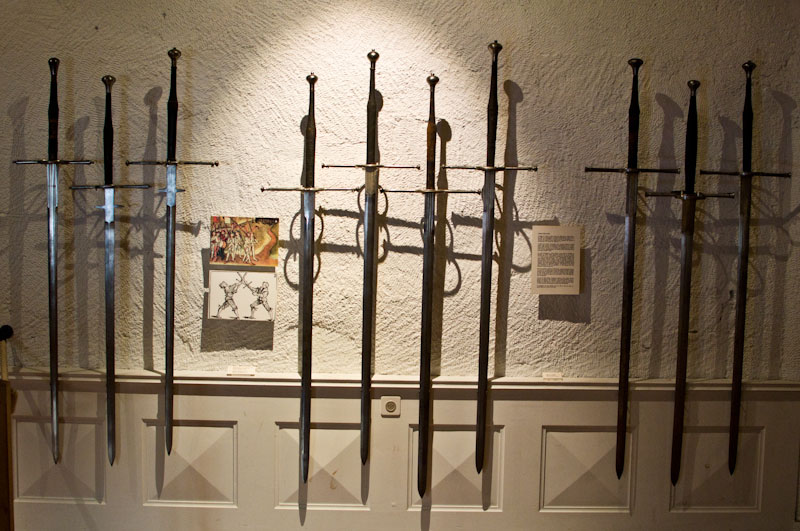
 Attachment: 165.68 KB Attachment: 165.68 KB
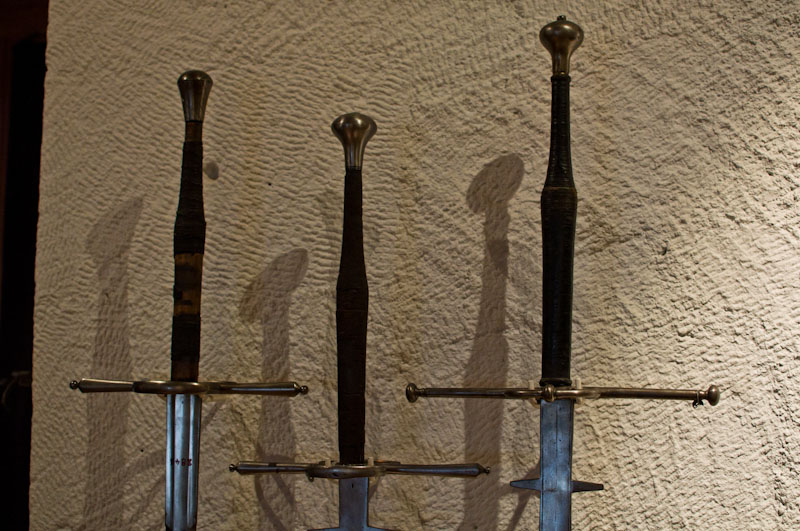
 Attachment: 189.16 KB Attachment: 189.16 KB
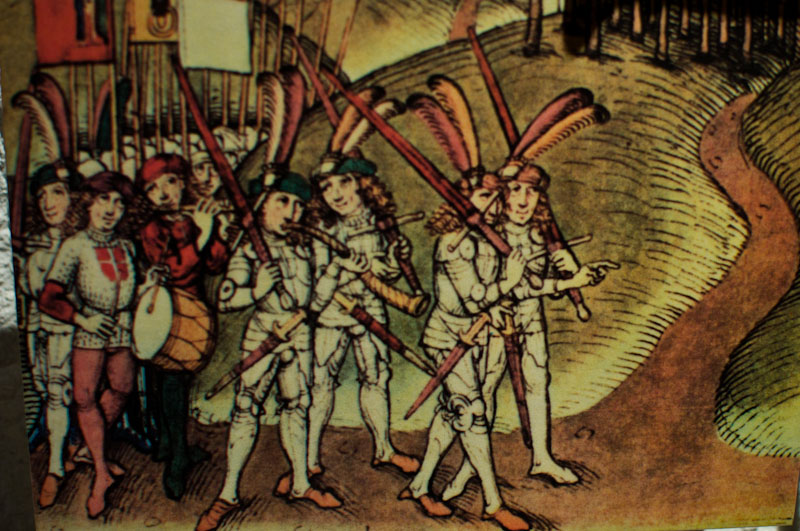
 Attachment: 101.68 KB Attachment: 101.68 KB
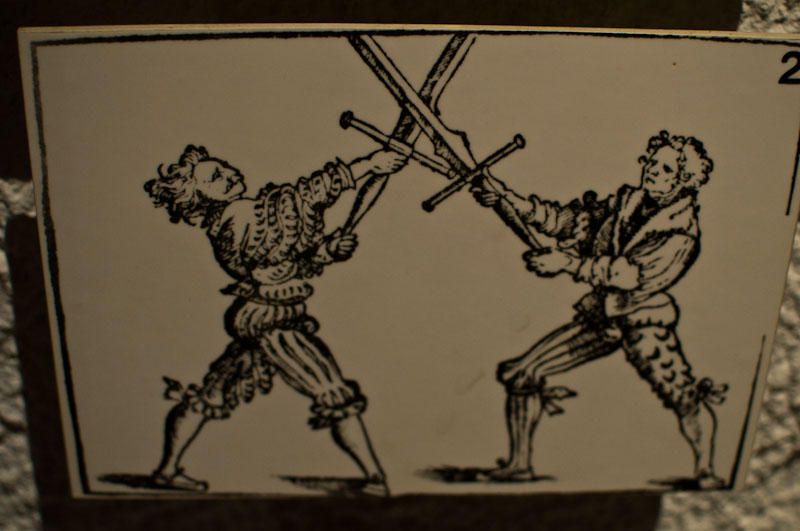
|
|
  |
 |
Luka Borscak

|
 Posted: Mon 04 Jun, 2012 2:49 pm Post subject: Posted: Mon 04 Jun, 2012 2:49 pm Post subject: |
 |
|
None of these look like a huge parade sword, I think they are all fighting two handers, as you say probably early 16th century, maybe north Italian, southern germanic and Swiss. Montante is just a spanish name for a two hander, so these would be montantes if used in Spain, zweihanders if used in German lands and spada da due mani (I think  ) if used in Italy. ) if used in Italy. 
|
|
  |
 |
|
Levente M.
Location: Hungary Joined: 19 Aug 2009
Posts: 35
|
 Posted: Mon 04 Jun, 2012 4:07 pm Post subject: Posted: Mon 04 Jun, 2012 4:07 pm Post subject: |
 |
|
|
Thank you Luka! I was always confused by the nomenclature of two-handed swords, I thought montante is the name of smaller two-handers used mainly in Spain.
|
|
  |
 |
Daniel Wallace

Location: Pennsylvania USA Joined: 07 Aug 2011
Posts: 580
|
 Posted: Tue 05 Jun, 2012 8:50 am Post subject: Posted: Tue 05 Jun, 2012 8:50 am Post subject: |
 |
|
i would classify these swords as montante. Luka is correct in stating that montante and zweihanders are assioated names for the style of sword. differences are quite simple from the montante i've been finding. their parrying lugs are close to the quillon block (nearly just enough for a single hand but not probable to be used in that way) and a slender blade usually hexagonal in dimension.
the point of having the parrying lugs so close to the guard is to protect the fingers when you have your index finger wrapped around the quillon (in an italian styled grip) at lest thats what i've gather from reading over parrier haken. other ideas on them are to keep a blade at bay - or a little use at helped to trap a blade. but after reading the "memorial" a montatne is not typically used to bind a blade at all.
even though these blades are thin, they pack a punch. their fairly thick at the tip of their blades, but i would believe a bit of sagging would be present in these swords. but a floppy blade is not necessarily a bad thing when we're talking about historical swords. this sword would actually be moving fast enough that a little sag in the blade wouldn't be noticed by the user. once in motion the user attempts to keep these heavy blades in motion. light montante are a little over 4lb, heavy is 6lb. not much but once you have that at 60 inches the swords feel blade heavy.
to break pike formations. i can't say that it's truly successful. a montante is an individual weapon - seemed to be used by elite guards for personal defence. and weapon that is individual in its purpose i believe fails against any kind of formal formation. 1 man with a pike vs montante is pretty reasonable but 100 pikemen in formation agains 100 men with montante is a whole different story. the sword is not meant to be used in a formation format.
where the two hander developed is hard to say. once the two hander caught on they seem to have been all over.
|
|
  |
 |
J. Hargis

|
 Posted: Tue 05 Jun, 2012 9:28 am Post subject: Posted: Tue 05 Jun, 2012 9:28 am Post subject: |
 |
|
Daniel Wallace:
| Quote: | | ... even though these blades are thin, they pack a punch. their fairly thick at the tip of their blades, but i would believe a bit of sagging would be present in these swords. but a floppy blade is not necessarily a bad thing when we're talking about historical swords. this sword would actually be moving fast enough that a little sag in the blade wouldn't be noticed by the user. once in motion the user attempts to keep these heavy blades in motion. light montante are a little over 4lb, heavy is 6lb. not much but once you have that at 60 inches the swords feel blade heavy. |
Excellent point when discussing what some call 'whippy' blades (there are various thread here on that topic). True, there are some instances when modern makers skimp on blade thickness for economic reasons, but Daniel's point emphasizes that blade flexibility is not necessarily 'whippy'. That overly used term is often applied by those who do not consider what the particular sword was designed for.
Apologies if I've gone too far off topic.
Jon
A poorly maintained weapon is likely to belong to an unsafe and careless fighter.
|
|
  |
 |
|
Josh S
|
 Posted: Tue 05 Jun, 2012 9:35 am Post subject: Posted: Tue 05 Jun, 2012 9:35 am Post subject: |
 |
|
| Daniel Wallace wrote: | | even though these blades are thin, they pack a punch. their fairly thick at the tip of their blades, but i would believe a bit of sagging would be present in these swords. but a floppy blade is not necessarily a bad thing when we're talking about historical swords. this sword would actually be moving fast enough that a little sag in the blade wouldn't be noticed by the user. once in motion the user attempts to keep these heavy blades in motion. |
Agreed. I noticed this quite drastically in the XIIIa I got from Michael Pikula. Its blade is just over forty inches long, and just over three inches wide at the base, with very little profile taper. When held statically with the edges parallel to the ground, the blade sags about four or five inches. But the first few times I tried cutting targets, I would whiff the air - the blade seemed to straighten quite a bit when in motion, due to centrifugal forces. When I adjusted my aim to compensate for the loss in sag, there was no issue.
|
|
  |
 |
|
Levente M.
Location: Hungary Joined: 19 Aug 2009
Posts: 35
|
 Posted: Wed 06 Jun, 2012 7:34 am Post subject: Posted: Wed 06 Jun, 2012 7:34 am Post subject: |
 |
|
Thanks!
I have no problem with blades being "whippy", as long as they are cutting swords. Thrusting swords shouldn't be too flexible though.
Can anyone recommend me a book/website or anything where I can find more information about montantes?
|
|
  |
 |
Daniel Wallace

Location: Pennsylvania USA Joined: 07 Aug 2011
Posts: 580
|
 Posted: Wed 06 Jun, 2012 9:28 am Post subject: Posted: Wed 06 Jun, 2012 9:28 am Post subject: |
 |
|
there was a discussion here not long ago where there was a new translation to Dogo's Memorial which is specific to the montante. i just can't remember the name of the topic.
montante is both a cut and thrusting sword, but i haven't seen any modern examples that we could used to base any information on as to how ridge they actually are. so stated - some of the bigger swords can sag a few inches when held - but if you see in any videos of how a montante is used they have a lot of big circular motion around the body which will cause that tip to straighten out. a user once stated that their going to act a little like an airfoil once they start to move. others have stated that once committed to a cut, its rather hard to stop because their so blade heavy.
i've been making a model of a montante for a the past few weeks in my shop to get an idea of the sword. and i can say they are very thin. not what you expect from a two hander and still be blade heavy. when i first got info about them i though they were training swords because they are so thin, but when you see the cross section data - it gives a different impression. the weight of the sword (i'm only estimating) is concentrated in the last 2/4 of the blade, the cross section at that point is pretty beefy and if it doesn't give a nasty cut, it's going to concuss like a sword that would look much more broad. physics at work it's a massy sword hidden behind a thin blade, made to move very fast = ouch.
montante has been compared to be as dangerous as a great flail (two handed styled flail) for it's ability to defend by attack.
|
|
  |
 |
|
Gary B. Ledford
Location: Southern California Joined: 14 Feb 2009
Posts: 38
|
 Posted: Tue 12 Jun, 2012 10:11 pm Post subject: Posted: Tue 12 Jun, 2012 10:11 pm Post subject: |
 |
|
| Luka Borscak wrote: | None of these look like a huge parade sword, I think they are all fighting two handers, as you say probably early 16th century, maybe north Italian, southern germanic and Swiss. Montante is just a spanish name for a two hander, so these would be montantes if used in Spain, zweihanders if used in German lands and spada da due mani (I think  ) if used in Italy. ) if used in Italy.  |
Don't forget the Italian spadone, which is a relatively light two hander when compared to the montante or zweihander.
Beware the Jabberwock my son,
The jaws that bite, the claws that catch!
|
|
   |
 |
|
Steve Hick
Location: United States Joined: 28 May 2009
Posts: 46
|
 Posted: Mon 18 Jun, 2012 10:45 am Post subject: Montante Posted: Mon 18 Jun, 2012 10:45 am Post subject: Montante |
 |
|
I believe we provide the dimensions of de Paredes' sword in the translation of Figueiredo's Memorial, this sword is middle 16th century. For comparison, the Cleveland Museum has online a photograph of one bidenhander between two montantes, more eloquent than words.
Steve
Steve Hick
|
|
   |
 |
|
Patrick De Block
Location: Belgium Joined: 10 Aug 2008
Posts: 84
|
|
  |
 |
|
Steve Hick
Location: United States Joined: 28 May 2009
Posts: 46
|
|
   |
 |
Craig Peters

|
 Posted: Wed 20 Jun, 2012 9:33 am Post subject: Posted: Wed 20 Jun, 2012 9:33 am Post subject: |
 |
|
|
I believe the image at the very bottom comes from the circa 1530 manuscript Der Altern Fechter Anfenglich Kunst published by Christian Egenolph.
|
|
  |
 |
|
Joe Karr
Location: Oakland ca Joined: 24 Jul 2010
Posts: 1
|
 Posted: Sun 24 Jun, 2012 11:45 am Post subject: Re: Two-handed swords in Morges Posted: Sun 24 Jun, 2012 11:45 am Post subject: Re: Two-handed swords in Morges |
 |
|
| Levente M. wrote: | Does anyone have any information on these swords? They are in the castle museum in Morges, Switzerland. The photos were taken in a rush, so sadly i have no information about them, other than that they are two-handed swords from the early 16th century.
So I have a couple of questions:
1. Are these swords considered zweihanders, montantes or just large longswords? Are they the famous two-handed swords used to break pike formations and guard banners, or just ceremonial swords?
2. The secondary guard is very close to the hilt on one of the swords, I doubt you can place your hand under it. What's the point then?
3. Are they typically Swiss swords, or just early german two-handers in general?
4. Are they replicas or original pieces? If original, they are in very good condition.
5. How would you date them? Is 1500-1530 a good guess?
6. There are many different blade types, hexagonal, diamond cross section, multiple fuller, one fuller etc. Is there any difference between these in terms of the blade's function?
7. I saw a post on this forum, in which there was a discussion about two-handed swords generally having thin, flexible blades. Is this true about these swords too, or is it dependent on the blade's cross section?
8. What are the 2 illustrations on the wall? Where are they from?
Any other information is welcome as well of course. 
Thanks in advance! |
ACTA NON VERBA
|
|
  |
 |
|
Matthew P. Adams
|
 Posted: Sun 24 Jun, 2012 12:18 pm Post subject: Posted: Sun 24 Jun, 2012 12:18 pm Post subject: |
 |
|
I would LOVE to see one of the "three A's" make a reproduction of this style weapon! Can we get a petition going or something? 
"We do not rise to the level of our expectations. We fall to the level of our training" Archilochus, Greek Soldier, Poet, c. 650 BC
|
|
  |
 |
|
David Gaál
|
 Posted: Mon 25 Jun, 2012 12:57 pm Post subject: Re: Two-handed swords in Morges Posted: Mon 25 Jun, 2012 12:57 pm Post subject: Re: Two-handed swords in Morges |
 |
|
| Levente M. wrote: | | 3. Are they typically Swiss swords, or just early german two-handers in general? |
I would recommend you the pages 85-87. from Seggern, B.- Der Landsknecht Im Spiegel Der Renaissancegraphik um 1500-1540. If you type it in google you will find it. I have tried to copy it from pdf but it doesn't let me do it, but you can download it freely if you really want more infos about Landsknechte and Reichslaufer.
http://en.wikipedia.org/wiki/Bastard_sword
Watch what is writen under the first picture.
Dávid
|
|
   |
 |
|
Levente M.
Location: Hungary Joined: 19 Aug 2009
Posts: 35
|
 Posted: Wed 27 Jun, 2012 3:09 am Post subject: Posted: Wed 27 Jun, 2012 3:09 am Post subject: |
 |
|
Thank you for all the great info!
I didn't have time to watch the thread and reply because of the exams, but i found out some things.
The swords are from central Europe, maybe Italy. They are from around 1500.
The picture of the men-at-arms holding the swords on their shoulders is from about 1475-1500. The swords in the picture are probably different from the ones on the wall.
There was also a sword in it's original scabbard, which I don't have a picture of. It is very similar to the others but a bit smaller. It looks more like the ones in the picture.
The museum cleary states that these are two-handers, Épée à deux mains. There was a hand and a half sword too, much smaller than the others.
I came to the conclusion that these are true two handed swords, used to defend banners etc. not to be used as a longsword.
Dávid, I think wikipedia shouldn't call these longswords, they are clearly different from the smaller swords seen in fechtbücher.
I'll try try to read the book you recommended, even though my german isn't all that great. 
|
|
  |
 |
|
David Gaál
|
 Posted: Wed 27 Jun, 2012 1:36 pm Post subject: Posted: Wed 27 Jun, 2012 1:36 pm Post subject: |
 |
|
| Levente M. wrote: | | Dávid, I think wikipedia shouldn't call these longswords, they are clearly different from the smaller swords seen in fechtbücher. |
I don't know it either, but if you change language to german in wikipedia you will get hand und ein halb and thats writen in that Doctor work which I posted that swiss Reichsleufer prefered hand and a half swords and Landsknecht's zweihander and thats really visible in pictures which were made in that times this two troops were rivals and they wanted to make difference between each other but a lot more is writen in details in that which I have posted.
Dávid
|
|
   |
 |
|
Neil Melville
|
 Posted: Wed 27 Jun, 2012 4:04 pm Post subject: Posted: Wed 27 Jun, 2012 4:04 pm Post subject: |
 |
|
The swords in the photograph are all Swiss and date to 1500-30. There are many almost identical in the History Museum in Bern and they are certainly fighting swords. The top picture shows Swiss soldiers returning home and is from the Spiezer Bilder Chronik of 1485 by Diebold Schilling.
Neil
N Melville
|
|
  |
 |
|
Levente M.
Location: Hungary Joined: 19 Aug 2009
Posts: 35
|
 Posted: Thu 28 Jun, 2012 2:18 am Post subject: Posted: Thu 28 Jun, 2012 2:18 am Post subject: |
 |
|
Dávid, I wouldn't call them hand and a half sowrds either, their grip is at least 40 cm long. You'd have to be a very strong individual to wield them with 1 hand.
Thanks Neil! I think I've seen the ones in Bern, too bad I was a child and can't remember 
Edit: I forgot one thing. I know the swiss preferred longswords and halbers and the landsknechts doppelhanders and katzbalgers. I even heard somewhere that in some parts of Switzerland the manufacturing of two handed swords had been banned. These longswords however are different to the big swords in Morges. I actually found a photo of a sword that was labeled as hand and a half in the museum. It's much smaller.
 Attachment: 69.07 KB Attachment: 69.07 KB
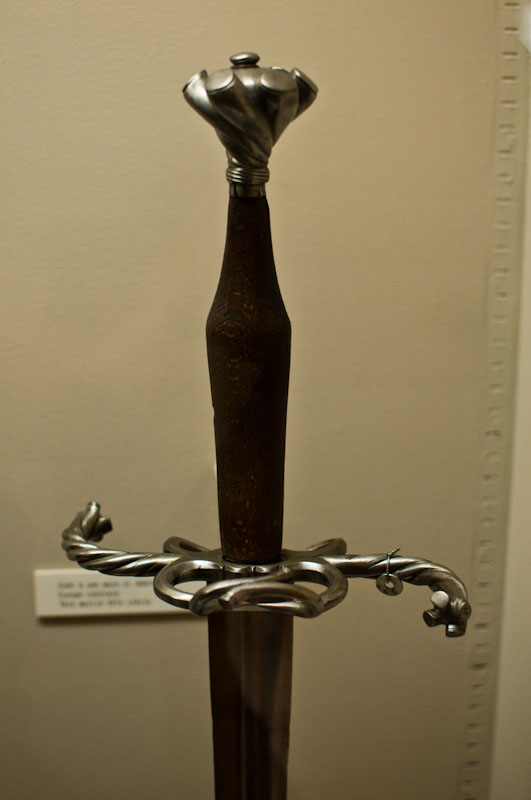
|
|
  |
 |
|
|

